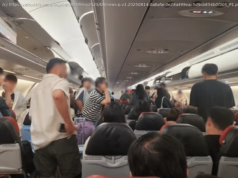There is a quiet effort underway to tone down any military rhetoric that could lead to North Korea viewing the Pentagon as warmongering, several US military officials have told CNN.
At the same time, the Pentagon is trying to lower its public profile regarding Navy ship transits through the South China Sea, which have provoked Chinese ire, as part of an overall administration effort to improve relations with Beijing so that it pressures Pyongyang to curb its nuclear weapons program.
The strategy comes in the wake of contradictory statements by President Donald Trump on his policy toward North Korea and growing tensions in the region over its nuclear and ballistic missile capabilities.
He warned of the possibility of a «major, major conflict» with Pyongyang at the end of April, and then days later said he would be willing to meet North Korean leader Kim Jong Un to defuse tensions.
The Obama administration had publicized the US Navy’s South China Sea ship transits, known as «Freedom of Navigation Operations, » to ensure Beijing was seen as not willing to acknowledge the area as international waters.
Under Trump, the US military’s sole request for such an operation was turned down by the Pentagon, a senior defense official told CNN.
The official said the denial stemmed from several factors, including an effort inside the Pentagon to turn down the temperature of operations that could be viewed as antagonizing China or North Korea.
The official said that led to a broader review of freedom of navigations operations, particularly those in the South China Sea, to ensure the military tactic squared with the overall US policy toward China — including diplomatic and political efforts that are taking a more conciliatory stance toward Beijing.
After months of hostile rhetoric on China, including the threat of calling the Asian power a currency manipulator, Trump has done a turnabout. He has now publicly complimented President Xi Jinping for trying to help with the North Korean crisis.
The review — which has been completed and a tentative schedule of transits laid out — has led to a crucial change in the public profile of the operations.
The Pentagon will no longer publicly discuss the missions on a routine basis, but instead once a year will merely publish a list of operations, officials said.
The effort is similar to the one toning down the rhetoric on North Korea, if for slightly different motivations.
With North Korea, several senior defense officials said there is now an effort to ensure as much public information as possible comes from commanders in South Korea and at the US Pacific Command in Hawaii, rather than from officials at the Pentagon in Washington to lessen its reach and perceived importance.
While the effort is not being publicly acknowledged due to its sensitive nature, the officials said even once-routine items are likely to be downplayed.
One key example occurred after the two recent B-1 bomber training missions over the Korean Peninsula.
In the past, these have been describe as «show of force» missions with public statements made by top officials.
In the recent B-1 bomber missions, however, reporters had to ask specific questions before getting answers. The term «show of force» was instead used on background by officials speaking anonymously.
The officials said in part that the Pentagon is taking these steps out of concern that a high-profile response, along with statements about North Korea made by Trump, could be interpreted by Kim as the Pentagon warmongering.
Домой
United States
USA — Korea Pentagon cools North Korea, China rhetoric to avoid warmongering label






